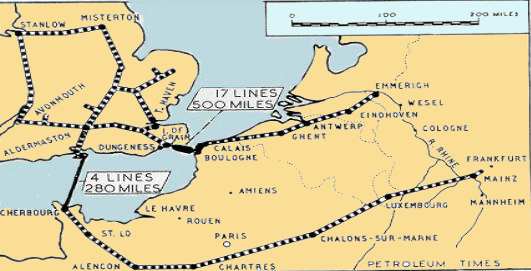Well I think at Omaha the higgins boats had to be carefull of stickmines. The Germans stuck mines to long poles so at high tide they couldnt be seen!
Hmmm… so just about the smallest problem the assault faced at Omaha somehow makes the landings on the other four beaches a marginal success? WTF?
That’s probably why they landed at low tide. A lot of mines were US due to salt water, as Rommel had predicted.
If things had started to go wrong then BC and Harris could be ordered to get involved in more detail. The casualties for the first day were a lot less than had been expected. The only real problem was the destruction or damage of the Mulberries (which are still visible on Google earth).
49 21’ 00" N, 0 37’ 45" W
Just in case anyone wondered. Eye alt of 7000-10000ft and you should see it, and can zoom in on details from there.



I would be interested on your thoughts as to why we barely made it on D-Day as I thought it went rather well myself?
I personally think we did it due to our supremacy in infantry (and naval crafts, of course) and the German’s unbelievable lack of a prompt response to the invasion.
Lots of minor failures have been reported, but which obviously led to higher casualty figures. The hazardous and fateful parachuters dropping at St. Mere L’Église, the inacuraccy of the air bombing previous to the invasion to destroy German’s guns and bunkers, the (in my opinion) insufficient sea bombing support from destroyers and battleships… It is also true that not in all beaches did we find as many difficulties as we found in most sectors at Omaha and Utah, but we should not forget that the aftermaths of those “little” mistakes entailed human casualties. and these are always too many.
The only real problem was the destruction or damage of the Mulberries
Can you be more specific on that, please? I understand that, despite a few problems due to their huge dimensions, the Mullberry docks were a great success and explain why so many people, weaponry and support were in Normandy only a few days after D-Day.
By the way, thanks for the pictures. 
There are two main reasons why the Germans failed to respond quickly. The first is well known - their utter conviction that the main thrust would come through the Pays de Calais. However, also look for information on Tedder’s ‘Transportation Plan’. The 2nd Tactical Air Force under Conninham and the 9th USAAF denied the Luftwaffe use of airfields within 200 miles of the Normandy beacheads allowing the Allied forces to maintain air supremacy over the battle area. They also destroyed transportation nodes, isolating the Germans from their logistic support and reinforcements.
To this we may add the fact that several fighter squads under the supervision of aviation prodigy Josef “Pips” Priller had been transferred miles away a few days before D-Day and could not possibly have returned until well after D-Day had been successfully concluded.
Hey Dani are those mulberries you posted still there after all these years?!?
Flame_thrower
Can you be more specific on that, please? I understand that, despite a few problems due to their huge dimensions, the Mullberry docks were a great success and explain why so many people, weaponry and support were in Normandy only a few days after D-Day.
There was a big storm a week or so after D-Day which damaged the one in the 21st army area. The storm destroyed the one in the US area and so all stores had to go through one area. The fuel was also pumped by pipeline from the Isle of Wight, Pipe Line Under The Ocean (PLUTO).

http://www.combinedops.com/pluto.htm
PLT.SGT.BAKER
Hey Dani are those mulberries you posted still there after all these years?!?
Yes.
Google earth is a compilation of sat photos. You can date most by what has changed. I cannot say for certain the date but should not be older than 3 years.
A few photos from Juno beach.

Reinforcements going ashore from a (LCA) Landing Craft Assault from H.M.C.S. Prince Henry off the Normandy bridgehead.

Personnel of Royal Canadian Navy Beach Commando “W” landing on Mike Beach, Juno sector of the Normandy beachhead.

On D-Day, the reserve brigade lands after Juno was secured.

Canadian soldiers hit the beaches and began the deadliest run of their lives. As they worked their way through the obstacles and minefields they came into the killing zones of the German gun positions.

On D-Day, the reserve brigade lands after Juno was secured.

Wounded await evacuation on Juno beach. (National Archives of Canada PA 133971).

D-Day: wounded soldiers lying on beach awaiting transfer to casualty clearing station, Normandy, France, 6 June, 1944.
Notice the tin bins and equipment on the RCNBC and in a number of other pictures they are seen with the new battle bowler.
Nice pictures thanks.
I will take this opportunity to welcome Erik!
Thanks for the welcome 8)
